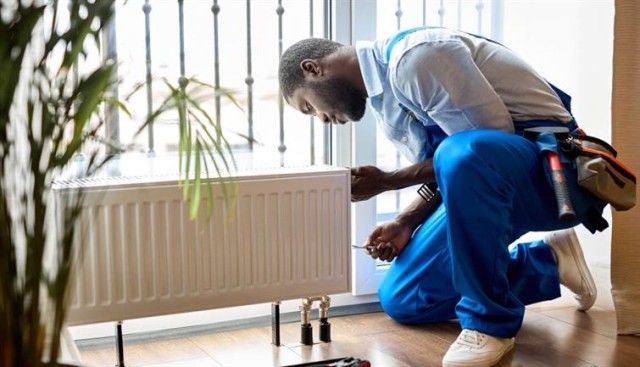It seems like every renter has either encountered the noisy neighbor, or as much as we don’t want to admit it, been the been the noisy neighbor ourselves. There’s no doubt about it, the closeness of apartment living means that noises from our neighbors comes with the territory. No one wants to receive a noise complaint, and no one wants to suffer at the hands of loud neighbors. Help quell your noise woes with these tips and tricks on soundproofing your apartment.
Soundproofing vs. Sound Absorbtion
Before getting into soundproofing suggestions, it’s essential to understand what soundproofing means. Soundproofing and sound absorption often get lumped together because soundproofing is generally an umbrella term used to define all noise blocking and enhancement techniques, but the two terms are actually different.
Soundproofing is blocking noise from entering or exiting by eliminating vibrations, therefore stopping sound waves. Soundproofing can be accomplished through a variety of techniques and helps those worried about sounds entering and exiting their apartment.
Sound absorption is when the sound waves get absorbed in a room eliminating echoes, reverberation, and amplification. While sound absorption doesn’t prevent noise leaks, it improves the quality of sound in your room by cutting down on echoes and background noises.
Why is my apartment so noisy?
Now that we know what the two terms mean, how do they work in an apartment? Sound reflects off hard surfaces like hardwood, tile, walls, and ceilings. Any noise in an empty room will sound amplified and echoey. Put a couch, area rug, and canvas paintings on the wall; the echo will be cut down or disappear because the sound is getting absorbed by these materials. Then, place a speaker in the corner of this same room so the back of the speaker is touching the wall and the bottom is touching the floor. The music within the room won’t echo because the room is filled with sound absorbing materials. However, the beat of the music will be heard throughout your complex. This is because vibrations create sound waves. To soundproof any room, you need to add mass around the source of the noise to prevent the vibrations from creating sound waves. While we can’t make structural changes to our apartments, there are renter-friendly soundproofing and sound absorption methods renters can use.
Identify the Noise Problem
Step one in soundproofing your apartment is to find out where the source of either the noise leaks or noise entrances are. For example, if you’re getting noise complaints due to loud music, you’ll want to focus on soundproofing walls and floors. If you’re disturbed by loud noises from the busy street below your apartment, you’ll likely need to focus on soundproofing windows and doors.
Another key step in identifying noise issues is identifying whether it’s the fault of people or structural issues. Older buildings are built in ways that don’t account for soundproofing and likely have older pipes that cause loud noises. Find out the cause of the excessive noise to make sure you’re soundproofing in the correct way.
Room Soundproofing
No room is going to be able to eliminate all noise from leaking out or in but using a variety of soundproofing and absorption techniques will make a noticeable difference.
Furnish your apartment
Filling the room with fluffy, cozy furniture is the best way to eliminate loud noise within your apartment because rugs, blankets, and couches, etc. all absorb sound. While furniture and rugs don’t stop sound waves from entering or exiting a room, they cut down on echoes and amplified noises from within the room.
White noise machine
A white noise machine doesn’t do anything in the way of preventing noise leaks into or out of your apartment, but it helps drown out unwanted noise. If you’re dealing with loud noises from all around, a white noise machine will help distract you from them, especially at night. Purchase a white noise machine, make a white noise playlist on a music curation app, or point a standing fan towards the wall to create a humming noise. The soft, consistent noise will help cancel out the nuisance sounds.
Eliminate vibrations
Put foam or another sound absorbing material around the noise-causing item to reduce the vibrations. For example, if you have a speaker, place foam underneath and around it to cut down on the vibrations coming from the speaker. Remember to eliminate sound waves you need to eliminate vibrations.
Wall Soundproofing
If you’re dealing with a loud neighbor or you’re setting up something like a music room, you’ll want to pay special attention to your shared walls. The key to soundproofing your walls is to make sure as little vibrations as possible are getting through the walls.
Mass loaded vinyl
Mass loaded vinyl is one of the most effective materials to use for soundproofing. Builders typically add it to the interior of walls and doors, but it can still be hung on the exterior of walls or underneath rugs. Mass loaded vinyl isn’t the most interior décor-friendly material, but you can hide it under items to make it work. For example, laying it under a fluffy rug will cut-down the noise your downstairs neighbors hear. You can also hang it behind shelves so it’s not visible on the wall.
Acoustic wall panels
Depending on the ones you buy, acoustic panels do help a bit with soundproofing, but their main purpose is to create a quiet interior through sound absorption. If you hang them up, the interior of your home will have a quiet, dry sound, but they need to be paired with other methods in order to achieve soundproofing.
Add bookshelves
Bookshelves filled with your favorite books and trinkets are a great soundproofing method. From the previous description, we know that extra mass stops vibrations, making filled bookshelves a soundproofing hero. Consider purchasing one or more bookshelves to place along your shared walls.
Hang art
Wall art won’t only add character to your apartment; it will help with your soundproofing process. Canvas art, tapestries, or other art made on soft materials help cut down on echoes and amplification as well as prevent sound from escaping through the walls because it adds a bit more mass to the wall.
Ceiling Soundproofing
Whether you’re dealing with a loud upstairs neighbor or trying not to become the loud upstairs neighbor, you’re in luck. There are ways to cut down on sound entering and exiting through the ceiling.
Hang tapestries
Go for a boho look and hand curtains or tapestries from the ceiling. If you’re dealing with your upstairs neighbor’s loud stomping, the curtains or tapestries will help absorb and trap the sound from the floor above you. Ceilings are flat and hard, so adding anything to make a soft, textured surface will prevent the upstairs noise from being a nuisance.
Thick rug with a rug pad
Don’t be the loud upstairs neighbor. Cut down on sound leaking through your floors with a thick area rug and rug pad. You can even add an extra layer of soundproofing to your rug by slipping mass loaded vinyl under the rug pad as well. Now, you can rest easy knowing your at-home workout, loud footsteps, or music session isn’t bothering your downstairs neighbor.
Door Soundproofing
In many cases, the front door is the biggest culprit for noise issues. Most apartment communities have hollowed doors instead of solid doors, which leads to noise issues. Luckily, there are ways to cut down on noise problems even if you have a hollow door.
Weatherproof
Weatherproofing doors and windows won’t only cut down on utility costs; it will cut down on noise leaks as well. Install a draft stopper (aka a door gasket or door sweep) under doors and windows to prevent noise from escaping and entering your home.
Seal gaps
There are several ways to seal gaps around your door. Seal gaps by using foam, silicone, or tape. Hardware stores also carry special noise reducing tape and acoustical caulk. It may seem like you’re not doing much, but this small fix makes a noticeable difference.
Soundproofing panels
For a DIY soundproofing approach, use more mass loaded vinyl. Cut the vinyl into the same shape as your door, add adhesive strips to the back of it, and stick it to your door.
Soundproof blanket
A soundproof blanket is a good option for renters who don’t like the look of always having the vinyl on their door but still need to block out noises occasionally. If you’re dealing with loud noises at night or you want to prevent loud noises during a party or a drum session, place a soundproof blanket over the door. Hang hooks or a curtain rod over your door so you can easily take the blanket on and off. If you don’t want to invest in a soundproof blanket, a thick, velvet curtain works as well.
Window Soundproofing
Like your front door, your windows are a top culprit for noise leaks. You can use many of the same methods for soundproofing your windows that you would on your front door, but there are a few additional techniques you can implement.
Window inserts
If the main cause of your noise woes are coming from outside, window inserts could be a lifesaver. The most effective window inserts are made out of laminated glass and can be a bit pricey. If you live in an area with a lot of noise coming from the outside, window inserts may be worth the money. It would be a good idea to ask your landlord about installing them. Make a case to your landlord explaining that the window inserts will make the unit more appealing, since no one wants to rent a noisy apartment. If window inserts aren’t right for you, rest assured because there are other methods you can use to cut down on noise.
Soundproof curtain
If window inserts are out of the question, soundproof curtains are a great alternative. Special soundproof curtains can be purchased, but you can go the DIY route as well with thick, velvet curtains. Soundproofing curtains are hung like any other curtain, but make sure that the rod is able to withstand the weight of the curtain.
Weatherproof
In the same way you’d seal your door, seal your window by making sure all gaps are filled. Draft stoppers can be purchased for windows, and you can fill in gaps around the window with soundproofing caulk and tape the same way you would around the door.
No one fix is going to solve all your noise issues, but using a variety of techniques should make a remarkable difference. Just because you live in an apartment doesn’t mean you shouldn’t be able to have late-night jam sessions or that you have to be at the mercy of other people’s noises. Use these suggestions to get back to enjoying your everyday life at your preferred noise level!






